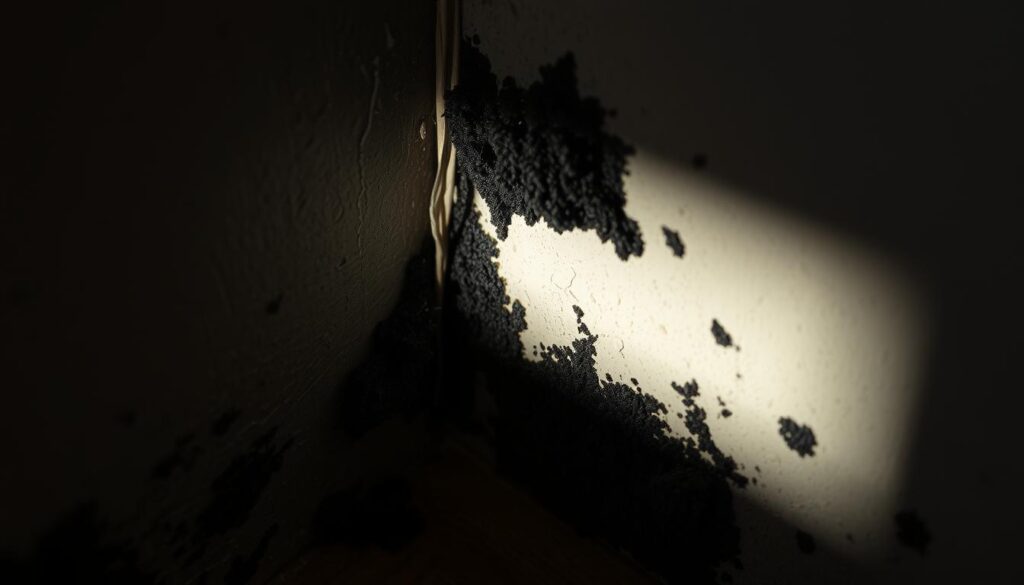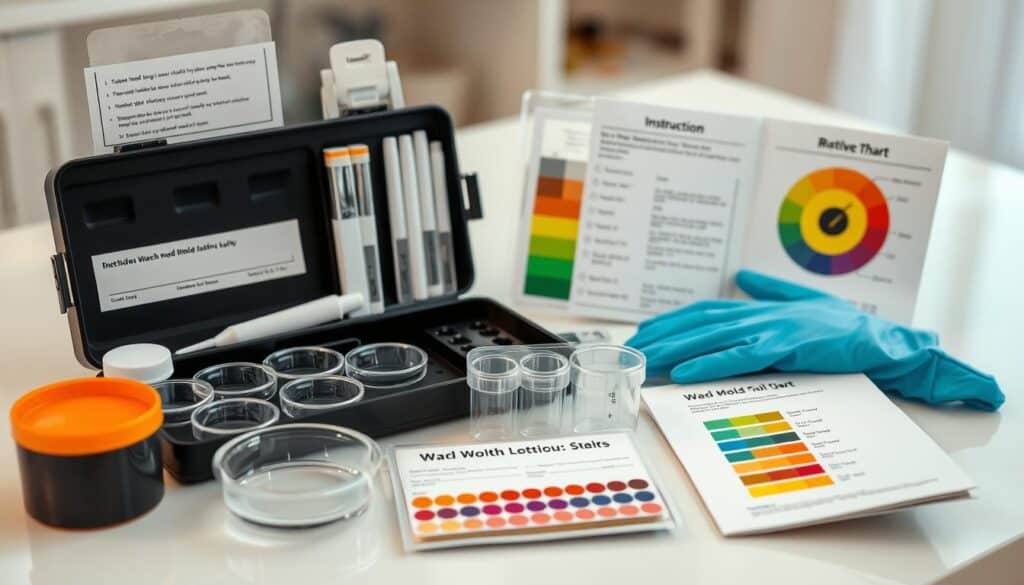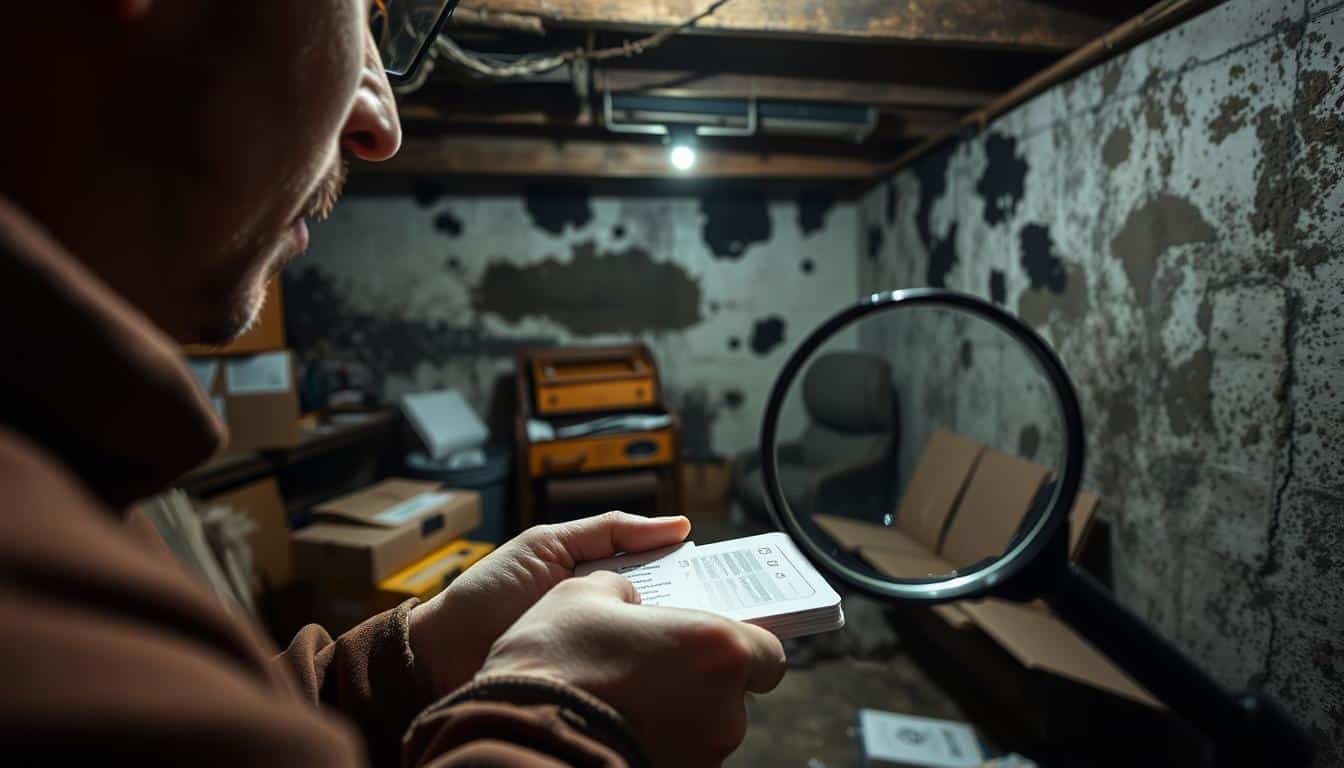Did you know over 300 species of Penicillium mold can hide in your home? They can cause allergic reactions and breathing problems. This shows why black mold testing and checking indoor air quality are so important. I’ve explored the world of toxic mold detection to keep your home safe.
Black mold, also known as Stachybotrys chartarum, loves damp places. It’s not just ugly; it can be harmful to your health. The Centers for Disease Control and Prevention (CDC) says mold can lead to coughing, wheezing, skin issues, and feeling tired.
But black mold isn’t the only danger. Aspergillus, with 185 species, can also be harmful. It can cause breathing infections, especially in people with weak immune systems. That’s why finding and removing all mold is key to a healthy home.
In this guide, I’ll show you how to spot, test, and fix black mold problems. You’ll learn about DIY methods and professional services to keep your home healthy. Let’s start our journey into black mold testing.
Key Takeaways
- Black mold can cause various health issues, from mild allergies to severe respiratory problems
- Multiple mold species, including Penicillium and Aspergillus, can grow in homes
- DIY mold testing kits are available, but professional inspections offer more comprehensive results
- Early detection and mold prevention strategies are crucial for maintaining a healthy home environment
- Proper protective equipment is essential when dealing with mold
Understanding Black Mold and Its Health Risks
Black mold is a toxic threat in our homes that we need to know about. As a homeowner, I’ve learned how important it is to understand this danger. It can affect our health in big ways.
What is black mold?
Black mold, also known as Stachybotrys chartarum, grows in damp, humid places. It looks like greenish-black spots on surfaces like drywall, wood, or fabric. This toxic mold needs moisture and can spread fast in places with poor air flow.
Health effects of black mold exposure
Being around black mold can cause health problems. Not everyone gets sick, but those with allergies or weak immune systems are at higher risk. Symptoms can be mild, like allergies, or serious, like breathing issues. In some cases, long-term exposure can lead to even worse health issues.
Common symptoms of mold-related illnesses
It’s important to know the signs of mold exposure. Common symptoms include:
- Coughing and wheezing
- Nasal congestion
- Eye irritation
- Skin rashes
- Headaches and fatigue
If you think you have mold at home, get a professional mold inspection. A mycotoxin test can find harmful mold substances. This helps spot health risks early. Early detection and fixing the problem are key to a healthy home.
Identifying Black Mold in Your Home
Spotting black mold is vital for a healthy home. As a homeowner, I’ve seen how early detection stops big problems and health issues. Let’s look at how to find black mold and where it likes to grow.
Visual Signs of Black Mold
Black mold shows up as dark, round spots or patches. It feels slimy or fuzzy and smells musty. I’ve seen it in places that are wet.

Common Areas Prone to Mold Growth
Black mold loves warm, wet places. I find it often in:
- Bathrooms and showers
- Kitchens, especially under sinks
- Basements and attics
- Around windows and air conditioning units
These spots are wetter, making them mold’s favorite spots. Checking them often keeps the air inside your home clean.
The Importance of Early Detection
Finding mold early stops health problems and damage. I suggest checking for mold often, especially in wet areas. Look for water marks, color changes, or mold. Even if you can’t see it, a strong musty smell means it’s there.
Being careful and fixing mold problems fast keeps your home and family safe from black mold.
The Importance of Black Mold Testing
Black mold testing is key for a healthy home. People spend 90% of their time indoors, so good air quality is crucial. Mold can grow in just 24 to 48 hours, so acting fast is important.
I think a detailed mold inspection is the first step. It involves a thorough check with tools like moisture meters and thermal cameras. If there’s high moisture or visible mold, professional testing is needed.
Air quality testing for mold means collecting samples from different home areas. This helps find mold spores indoors. Surface sampling is also useful, taking samples from suspected mold areas for lab tests.
For suspected high mold levels, DNA/ERMI testing is recommended. This test takes multiple samples around your home. It gives detailed info on mold types and amounts.
Remember, mold inspection and testing should cover both inside and outside areas. This includes crawl spaces and HVAC systems. By focusing on black mold testing, you’re protecting your family’s health and your home’s value.
DIY Black Mold Testing Methods
Dealing with black mold at home can be tough. That’s why I want to share some DIY methods for mold detection. These can help you take control of your home’s health.
Surface Testing Techniques
Surface testing is a simple way to check for mold. I use swabs or test strips to collect samples from visible mold or suspect areas. This method is quick and can show if mold is present.
Air Quality Testing for Mold Spores
Air quality testing is key for detecting airborne mold spores. I use collection devices to capture these spores. It’s important to note that mold can grow in temperatures between 40 and 100 degrees F. So, regular testing is crucial.

Pros and Cons of Home Testing Kits
Mold testing kits are easy to find and affordable, costing between $10 to $40. They’re good for initial screening, but they have some downsides. Here’s a breakdown:
| Pros | Cons |
|---|---|
| Affordable | Limited accuracy |
| Easy to use | Results may take weeks |
| Provides initial insight | Doesn’t identify cause |
| No professional needed | May miss hidden mold |
While DIY testing is helpful, it’s important to remember that for mold growth over 10 square feet, you should get professional help. If you’re facing big mold problems, searching for “mold testing near me” can help you find experts for thorough mold detection and removal.
Professional Black Mold Testing Services
Professional mold testing services are a detailed way to find mold in your home. They use special tools and methods to find hidden mold and see how bad it is.
These services include air quality tests, surface samples, and bulk samples. They can find out what kind of mold you have and how much. This info is key for fixing the problem.
It’s good to know the cost of mold testing. The price can be from $250 to $1,100. Most people pay about $675. For homes of average size, it’s usually around $450.
| Testing Method | Cost Range |
|---|---|
| Swab Test | $180 – $320 |
| Air Testing | $240 – $360 |
| HVAC System Testing | $50 – $80 |
| Stain Testing | $100 – $160 |
| Mold Culture Test | $50 (additional) |
I suggest getting professional testing for big mold problems, strong smells without seeing mold, health issues, recent water damage, or when buying or selling a home. Mold can grow fast, in just 24 to 72 hours, if it’s wet enough. So, acting quickly is very important.
If you think there’s mold in your home, call certified experts for a mycotoxin test. They can keep your home safe and give you peace of mind.
Interpreting Black Mold Test Results
After a mold inspection, it’s key to understand the results. I’ll help you make sense of these findings. This way, you can check your indoor air quality and any health risks.
Understanding Mold Spore Counts
Mold spore counts show how much mold is in your home. A mycotoxin test can find levels from 0-50 spores (very clean) to over 10,000 spores (a lot). Air sampling is the best way to confirm mold.
| Spore Count | Classification | Action Required |
|---|---|---|
| 0-50 | Extremely Clean | No action needed |
| 51-500 | Normal | Regular cleaning |
| 501-2000 | Elevated | Investigate source |
| 2001-10000 | High | Professional remediation |
| 10000+ | Very High | Immediate action required |
Identifying Mold Species
Common indoor mold types are Penicillium, Aspergillus, and Cladosporium. Seeing hyphal fragments or clumped spores means mold is growing nearby. Comparing indoor samples to outdoor controls helps find mold sources.
Assessing Health Risks
There’s no health standard for indoor mold levels. But, some findings need attention. People with asthma or mold allergies are more at risk. If you’re feeling sick, talk to a doctor. Remember, seeing mold or musty smells is often a better sign than air sampling alone.
For full mold testing and advice, think about getting professional help. They can give detailed analysis and suggestions for better indoor air based on your test results.
Black Mold Prevention Strategies
Preventing black mold is key for good indoor air quality. The main thing is to control moisture in your home. Here are some ways to keep mold away:
- Fix leaks right away
- Use dehumidifiers in damp spots
- Make sure bathrooms and kitchens have good ventilation
- Clean and dry water-damaged areas quickly, within 24-48 hours
- Choose mold-resistant products for wet areas
- Check for water damage or mold often
Keeping indoor humidity between 30-50% helps prevent mold. Using exhaust fans in bathrooms and kitchens helps manage moisture. Also, make sure attic vents are clear for air flow.
Regular mold checks are vital. I use the NIOSH Dampness and Mold Assessment Tool to spot potential issues early. This way, I avoid expensive mold removal later.
Remember, mold is a sign of water problems. Fixing moisture issues quickly helps keep mold from growing. This ensures better air quality for your family.
Safe Black Mold Removal Techniques
Dealing with black mold can be challenging. It’s important to be careful and use the right tools. Let’s explore some safe ways to handle this problem.
Personal protective equipment for mold removal
Safety is crucial when removing mold. I wear a respirator, safety goggles, rubber gloves, and full-body clothing. This gear helps protect me from toxic mold spores.
Cleaning small areas of mold growth
For small mold areas, DIY removal works. First, I seal off the area and stop spores from spreading. Then, I mix white vinegar, water, and baking soda to clean the surface.
It’s key to scrub well and let the solution sit. After, I dry the area completely.
When to call professional remediation services
Big mold problems need experts. Professional mold remediation is best for large areas or porous materials. They have the right tools and know-how to safely remove mold.
Act fast – fixing water leaks and controlling moisture in 48-72 hours can prevent mold damage. This keeps your home safe and healthy.
FAQ
What is black mold?
Black mold, or Stachybotrys chartarum, is a greenish-black fungus. It grows on wood, fiberboard, and fabric in damp places. It can make harmful mycotoxins and cause health problems.
What are the common symptoms of black mold exposure?
Being around black mold can cause breathing issues like coughing and wheezing. It can also lead to nasal congestion, eye and skin irritation, headaches, and feeling tired. Long-term exposure can cause serious issues like chronic sinus infections, asthma attacks, and memory problems.
How can I identify black mold in my home?
Look for dark, circular spots or patches on surfaces, especially in wet areas like bathrooms and basements. It might feel slimy or fuzzy and smell musty.
Why is black mold testing important?
Testing for black mold is key to finding out how much mold there is and the health risks. It can find hidden mold and tell you about the types and amounts. This helps figure out the best way to clean it up.
What are some DIY black mold testing methods?
You can test for mold yourself by using swabs or test strips on surfaces. Air quality testing devices can catch airborne mold spores. But, home kits might not give as much detail as professional tests.
When should I consider professional black mold testing services?
Get a pro to test for mold if you have a lot of mold, strong smells without seeing mold, health problems, recent water damage, or when selling/buying a home. Experts use special tools and methods for better results.
How can I prevent black mold growth in my home?
To stop black mold, control moisture, fix leaks fast, and use dehumidifiers in wet areas. Make sure there’s good air flow, clean and dry water damage quickly, use mold-resistant products, and check for water damage or mold often.
What are safe techniques for black mold removal?
To safely remove mold, wear gloves, goggles, and respirators. Clean small areas with household cleaners and dry them well. For big areas or mold on porous materials, it’s best to get a pro to avoid spreading it further.




